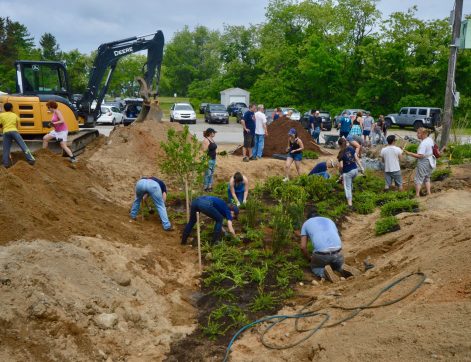By Marc F. Weller, P.E.
Two Pare engineers recently participated in the New England Water Environment Association (NEWEA) Young Professionals Committee’s first annual Community Service Project. The Committee’s goal was to build green infrastructure that would have an impact on a community and promote environmental sustainability. It was decided to construct a rain garden at the Common Fence Point Community Center in Portsmouth, Rhode Island.
Funding for the project was generously provided by the Van Beuren Charitable Foundation through the Rhode Island Green Infrastructure Coalition; and was supported by the Eastern RI Conservation District.
Once the project and location were determined, the members of the Young Professionals worked tirelessly to design and organize the details of the raingarden. All of this work paid off the day of the event! More than 45 volunteers gathered at the Common Fence Point Community Center, with most of the help coming from residents in the community. Six residents stood out for their dedication to the project by donating their professional expertise and use of heavy equipment for the project. Without the media outreach, excavation equipment, and horticulture expertise, we would not have been able to construct the raingarden. Many residents helped move loam and mulch, build a rip-rap spillway, and plant various shrubs and flowers. It was an incredible display of community camaraderie. The rain garden project was completed in about seven hours, which was much faster than expected and solely attributed to the amazing community support.
A rain garden is a depressed area in the landscape that collects and allows rain to slowly infiltrate into the ground, minimizing runoff and filtering the water. The 760-SF rain garden was designed to capture 50% of the runoff from the community center roof that would otherwise infiltrate into the ground and eventually discharge into the Mt. Hope Bay without any kind of treatment. Two roof leaders were tied together with new PVC drain pipe and discharged into to the rain garden. The rain garden was constructed using four inches of 50/50 loam/compost mix and 3-inches of pine bark mulch. Native plants are preferred in the rain garden because they have already adapted to local environmental conditions and require far less water. With this in mind, over 400 plants native to Rhode Island, including bearberry, milkweed, and azaleas, were planted within the garden bed. A small rip-rap spillway was also constructed to allow for the release of water that may build up in the garden during heavier rain events.
Since the day of the event, the community has taken a special interest in the rain garden and have added approximately $4,500 of additional plants and material! In addition to adding new flowers along the perimeter, large stones have been installed to help stabilize the slopes. The rain garden has really become a reflection of the camaraderie of the Common Fence Point community.
The project was a great experience to help a community that was engaged and willing to help …and we had fun doing it! Several residents shared how the community center used to be the focal point of the neighborhood. Movie nights, dances, and impromptu neighborhood parties used to be a staple at the community center, but for one reason or another, those activities have become few-and-far-between in recent years. This event helped revitalize that sense of community, and we are optimistic that this construction will help inspire the return of those community events.
From an engineering point of view, we enjoyed putting the design skills cultivated on other projects at Pare into use on this community project. It was a great experience to actually get our hands dirty planting this raingarden side-by-side with our neighbors.
Learn more about raingardens on the Environmental Protection Agency Rain Garden Information Website and how you can install one in your own community.


